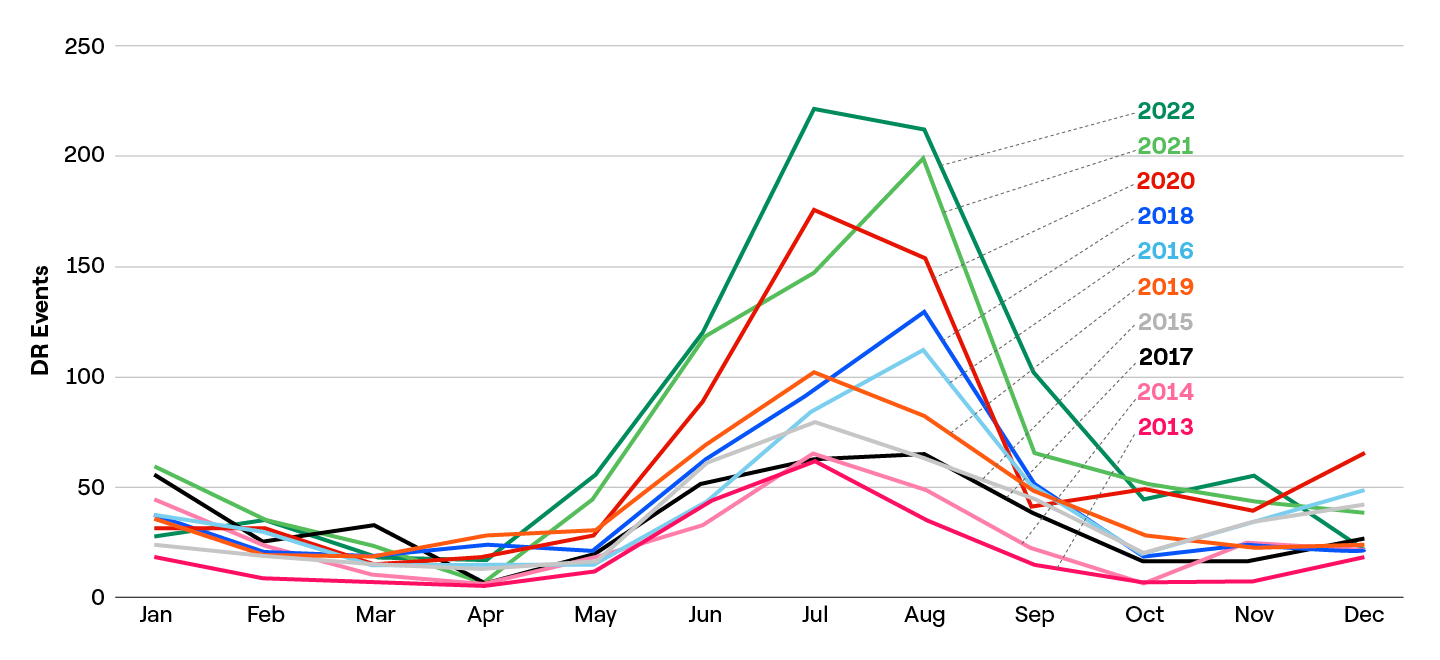02 10, 2023
{{ content.title }}
{{ content.description }}
Demand response offers unique value to organizations – by participating in demand response programs, they can earn lucrative payments for agreeing to reduce their energy use during times of electricity grid stress. Demand response programs are a valuable resource for utilities and grid operators to make the grid more resilient and ensure energy continues flowing in the face of growing challenges like extreme weather and aging electric grids.
In recent years, there has been a clear trend of increasing demand response events, and that trend continued in 2022. The numbers show that demand response participants are making a crucial contribution to their local community in helping to ensure grid reliability. Not only that, but if these trends continue in 2023, they show that the future holds more and more opportunities for demand response participants to earn revenue while supporting the grid.
2022 demand response by the numbers
When grid instability prompts a need for a demand response event, the grid operator or utility calls upon resources like demand response participants to reduce their energy consumption. As a pioneer of demand response since the early 2000s, Enel North America experienced a record number of demand response events in 2022. Here are some of the most notable figures for 2022:
- For North America’s annual total, we saw more than 700 demand response events.
- These 700 demand response events totaled 5,530 hours and 38,063 MWh dispatched.
The diagram below reflects the record year Enel North America experienced for demand response events.

We thank our customers for their crucial contributions to the grid during these events. The performance of our customers in these programs this year made a significant contribution to the reliability and stability of the energy grid.
Our customers also earned meaningful revenue from their demand response participation. In total, Enel North America customers received over $150 million in payments from demand response in 2022. These payments are well deserved. Demand response participants are offering a vital service, as reliable energy is essential for every aspect of the modern economy and modern life. Demand response customers are doing their part to keep communities as safe as possible during times of grid stress.
The biggest demand response events of 2022
With 700 demand response events during the year, there are countless stories to tell. A few of the most significant demand response events this year included:
- In June, a localized outage in Ohio led to nearly 20 hours of demand response events, helping relieve strain on the grid after a sub-station went down.
- In September, an intense heatwave in California led to 4 days of demand response events. Demand response helped to reduce demand and stabilize and relieve strain on the grid.
- Extreme cold on December 23 and 24 led to demand response events across much of the Northeast, Mid-Atlantic, and Southeast. Demand response was part of a broader emergency response that helped the country “narrowly escape an even worse calamity,” according to Bloomberg.
Why demand response increased – and what to expect in the future
The trend of increasing demand response events has been apparent over several years, and we’ve identified three main factors contributing to this increase:
- Extreme weather: The growing frequency and intensity of severe weather is a major factor, as these events stress the grid by affecting both the demand side and the supply side. On the demand side, a jump in heating or cooling needs increases energy demand significantly, while on the supply side, generation and transmission can become more difficult during times of extreme weather. At these times, demand response is a crucial tool to help ensure supply and demand remain balanced.
- An aging grid: It’s not only extreme weather, though – the grid is aging and changing, and that’s another factor that makes balancing supply and demand in real time more challenging. Demand response helps to balance these unanticipated system imbalances.
- Lucrative, fast-response programs: Fast-response demand response programs (ancillary services) are being used more often to balance the grid. As the name implies, these programs require organizations to decrease energy usage much more quickly than through traditional demand response programs. These programs can be very lucrative for organizations that have the flexibility to respond in time.
Are you leaving money on the table?
These trends don’t entirely explain the increase of demand response events in 2022 – but they do show the increasing opportunity for demand response participants over the coming years. If these trends continue, 2023 could be another record year. There is massive potential for organizations to generate revenue by participating in demand response. Organizations that don’t participate are leaving money on the table.
Demand response is a win-win. It supports the grid. It benefits the local community. And it creates a revenue-generating opportunity for organizations.
Contact our demand response team to learn about how you can participate, or use our demand response calculator for a quick online estimate.